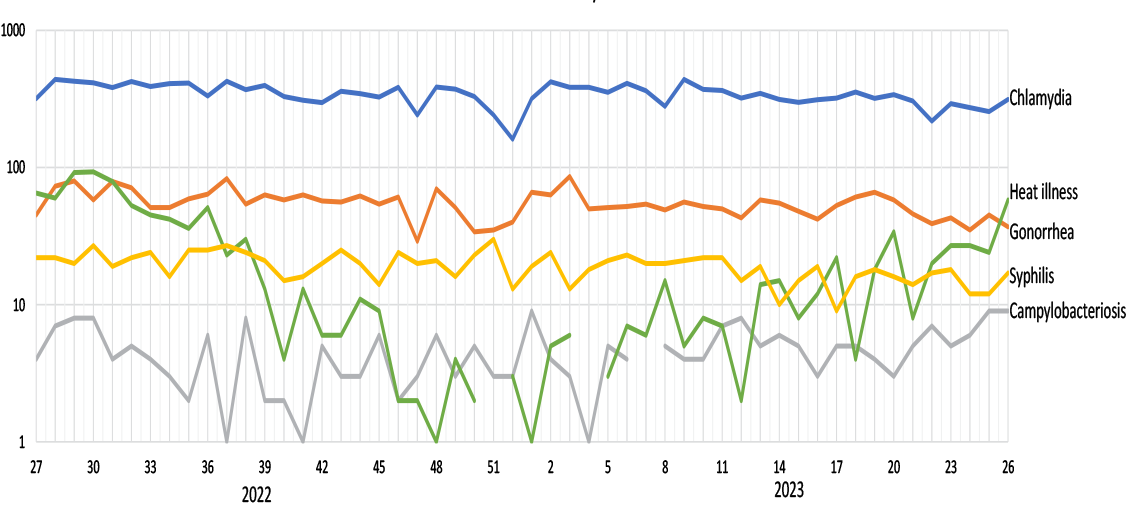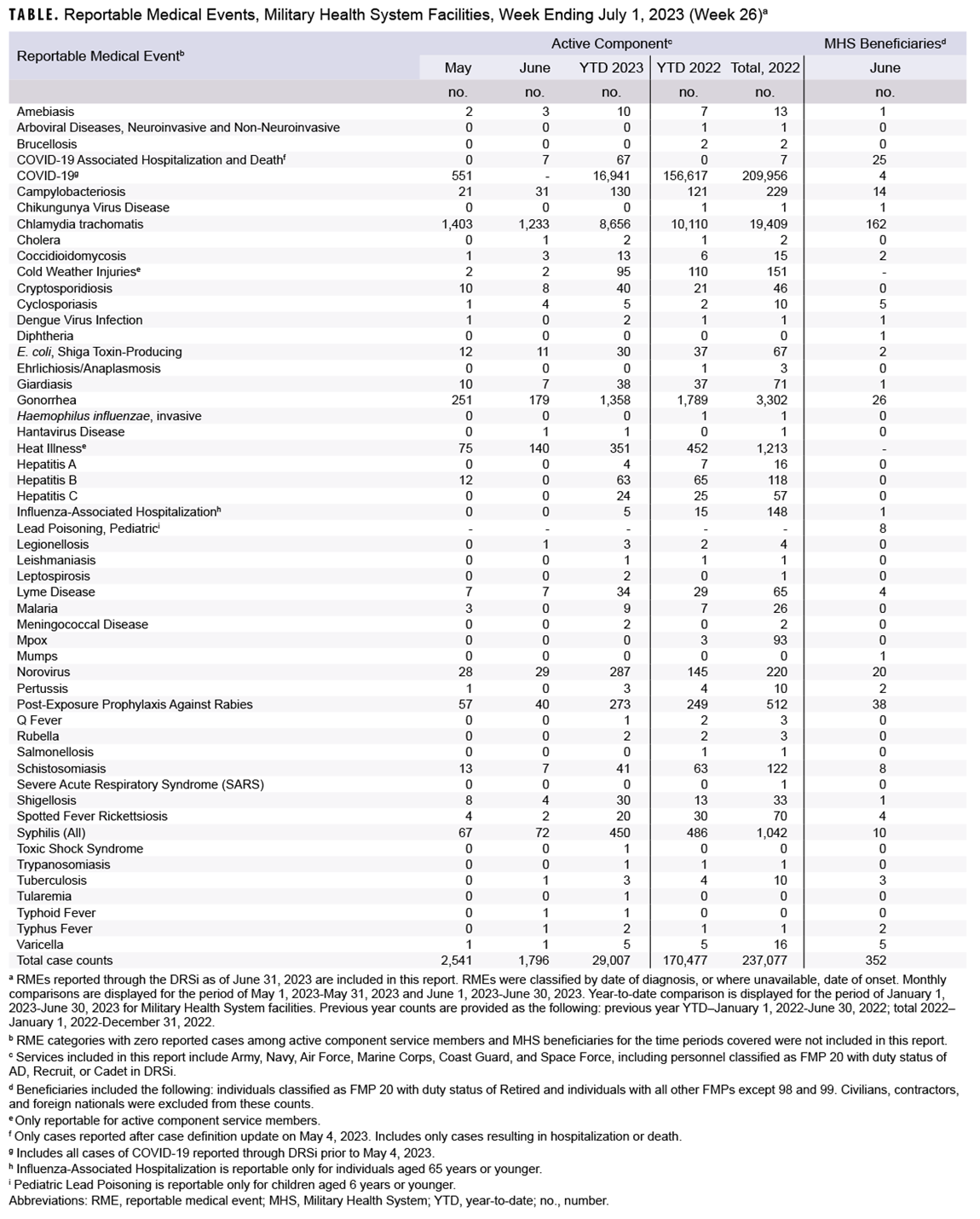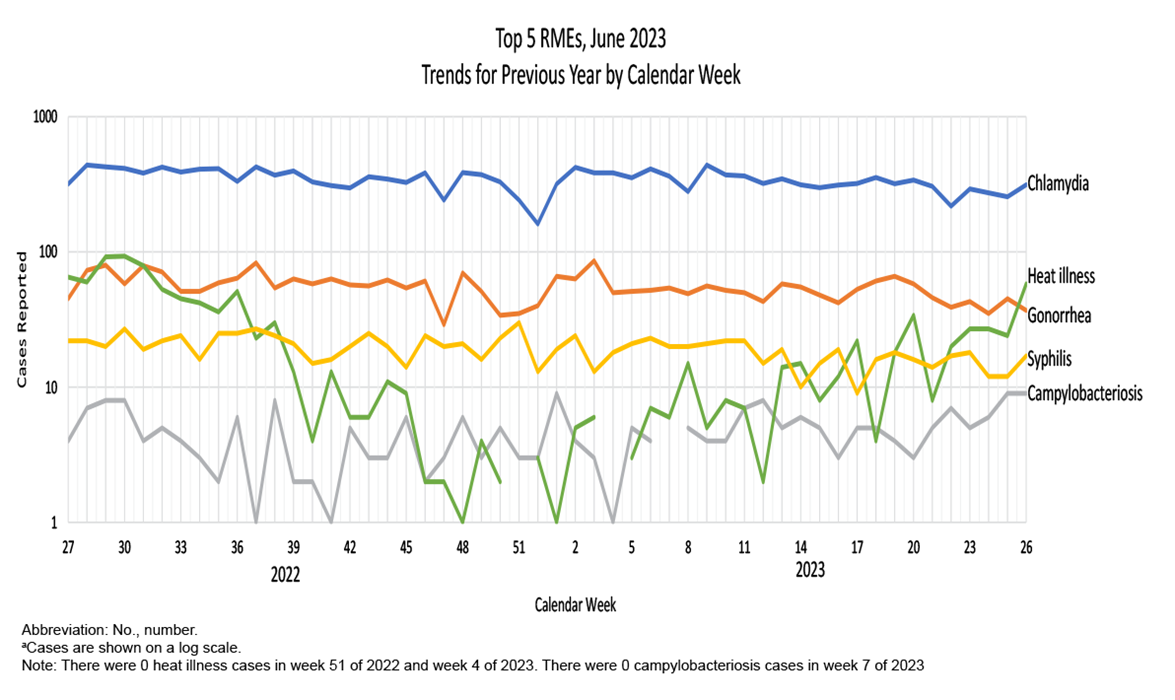Reportable Medical Events, Military Health System Facilities, Week 26, Ending July 1, 2023
 Top 5 Reportable Medical Events by Calendar Week, Active Component, July 9, 2022-July 1, 2023
Top 5 Reportable Medical Events by Calendar Week, Active Component, July 9, 2022-July 1, 2023
Reportable Medical Events are documented in the Disease Reporting System internet by health care providers and public health officials throughout the Military Health System, for monitoring, controlling, and preventing the occurrence and spread of diseases of public health interest or readiness importance. These reports are reviewed by each service’s public health surveillance hub. The DRSi collects reports on over 70 different RMEs, including infectious and non-infectious conditions, outbreak reports, STI risk surveys, and tuberculosis contact investigation reports. A complete list of RMEs is available in the 2022 Armed Forces Reportable Medical Events Guidelines and Case Definitions.1 Data reported in these tables are considered provisional and do not represent conclusive evidence until case reports are fully validated.

Total active component cases reported per week are displayed for the top five RMEs for the previous year. Each month, the graph is updated with the five most frequent RMEs, and is presented with the current month’s (June 2023) five most frequent RMEs, which may differ from previous months. COVID-19 is excluded from these graphs due to changes in reporting/case definition updates in 2023.

References
- Armed Forces Health Surveillance Division. Armed Forces Reportable Medical Events. Accessed April 6, 2023. https://www.health.mil/Military-Health-Topics/Health-Readiness/AFHSD/Reports-and-Publications
- Defense Manpower Data Center. Department of Defense Active Duty Military Personnel by Rank/Grade of Service, October 31, 2022. Accessed August 9, 2023. https://dwp.dmdc.osd.mil/dwp/app/dod-data-reports/workforce-reports
- Defense Manpower Data Center. Armed Forces Strength Figures for January 31, 2023. Accessed August 9, 2023. https://dwp.dmdc.osd.mil/dwp/app/dod-data-reports/workforce-reports
- Navy Medicine. Surveillance and Reporting Tools–DRSI: Disease Reporting System Internet. Accessed August 9, 2023. https://www.med.navy.mil/Navy-Marine-Corps-Public-Health-Center/Preventive-Medicine/Program-and-Policy-Support/Disease-Surveillance/DRSI
You also may be interested in...
Policy
Dec 11, 2019
 .PDF |
312.64 KB
.PDF |
312.64 KB
The Armed Forces Reportable Medical Events Guidelines and Case Definitions (RME Guidelines) standardize reporting and tracking of disease and other conditions of public health and military importance. Timely reporting permits earlier recognition of public health events and interventions to protect the health of the force.
- Identification #: N/A
- Type: Memorandum
Policy
Jun 13, 2013
 .PDF |
602.50 KB
.PDF |
602.50 KB
In July 2012, the President released the National Strategy for Biosurveillance (Strategy), directing Federal departments and agencies to improve national biosurveillance capability within existing resources. This interim guidance directs actions within existing Department resources to improve the integration, synchronization, and coordination of ...
- Identification #: N/A
- Type: Memorandum
Policy
Feb 26, 2008
 .PDF |
212.09 KB
.PDF |
212.09 KB
In accordance with DOD Directive 5101,1, "DOD Executive Agent," Sept. 3, 2002, this memorandum designates the Secretary of the Army as the DOD Executive Agent for the AFHSC, which includes the Defense Medical Surveillance System and the DOD Serum Repository.
- Identification #: OSD 02140-08
- Type: Memorandum
You are leaving Health.mil
The appearance of hyperlinks does not constitute endorsement by the Department of Defense of non-U.S. Government sites or the information, products, or services contained therein. Although the Defense Health Agency may or may not use these sites as additional distribution channels for Department of Defense information, it does not exercise editorial control over all of the information that you may find at these locations. Such links are provided consistent with the stated purpose of this website.
You are leaving Health.mil
View the external links disclaimer.
Last Updated: September 05, 2023